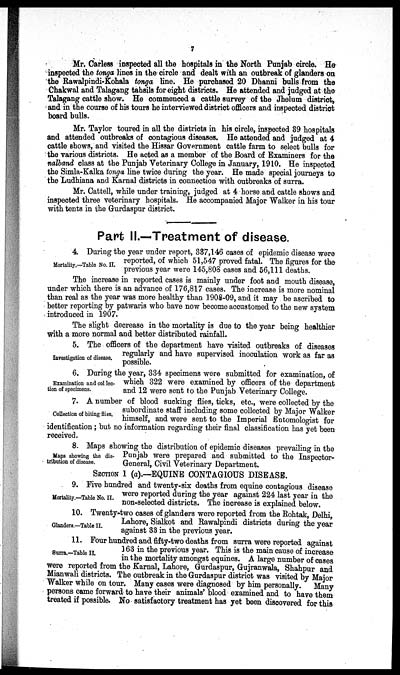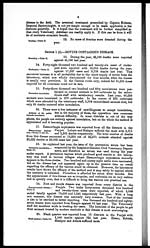Medicine - Veterinary > Civil Veterinary Departments > 1894-1932 - Annual report of the Punjab Veterinary College and of the Civil Veterinary Department, Punjab > 1909-1919 > 1909-1910 - Annual report of the Punjab Veterinary College and of the Civil Veterinary Department, Punjab for the year 1909-10
(63) Page 7
Download files
Individual page:
Thumbnail gallery: Grid view | List view

7
Mr. Carless inspected all the hospitals in the North Punjab circle. He
inspected the tonga lines in the circle and dealt with an outbreak of glanders on
the Rawalpindi-Kohala tonga line. He purchased 20 Dhanni bulls from the
Chakwal and Talagang tahsils for eight districts. He attended and judged at the
Talagang cattle show. He commenced a cattle survey of the Jhelum district,
and in the course of his tours he interviewed district officers and inspected district
board bulls.
Mr. Taylor toured in all the districts in his circle, inspected 39 hospitals
and attended outbreaks of contagious diseases. He attended and judged at 4
cattle shows, and visited the Hissar Government cattle farm to select bulls for
the various districts. He acted as a member of the Board of Examiners for the
nalband class at the Punjab Veterinary College in January, 1910. He inspected
the Simla-Kalka tonga line twice during the year. He made special journeys to
the Ludhiana and Karnal districts in connection with outbreaks of surra.
Mr. Cattell, while under training, judged at 4 horse and cattle shows and
inspected three veterinary hospitals. He accompanied Major Walker in his tour
with tents in the Gurdaspur district.
Part II.—Treatment of disease.
Mortality.—Table No. II.
4. During the year under report, 337,146 cases of epidemic disease were
reported, of which 51,547 proved fatal. The figures for the
previous year were 145,808 cases and 56,111 deaths.
The increase in reported cases is mainly under foot and mouth disease,
under which there is an advance of 176,817 cases. The increase is more nominal
than real as the year was more healthy than 1908-09, and it may be ascribed to
better reporting by patwaris who have now become accustomed to the new system
introduced in 1907.
The slight decrease in the mortality is due to the year being healthier
with a more normal and better distributed rainfall.
Investigation of disease.
5. The officers of the department have visited outbreaks of diseases
regularly and have supervised inoculation work as far as
possible.
Examination and collec-
tion of specimens.
6. During the year, 334 specimens were submitted for examination, of
which 322 were examined by officers of the department
and 12 were sent to the Punjab Veterinary College.
Collection of biting flies.
7. A number of blood sucking flies, ticks, etc., were collected by the
subordinate staff including some collected by Major Walker
himself, and were sent to the Imperial Entomologist for
identification; but no information regarding their final classification has yet been
received.
Maps showing the dis-
tribution of disease.
8. Maps showing the distribution of epidemic diseases prevailing in the
Punjab were prepared and submitted to the Inspector-
General, Civil Veterinary Department.
SECTION 1 (a).—EQUINE CONTAGIOUS DISEASE.
Mortality.—Table No. II.
9. Five hundred and twenty-six deaths from equine contagious disease
were reported during the year against 224 last year in the
non-selected districts. The increase is explained below.
Glanders.—Table II.
10. Twenty-two cases of glanders were reported from the Rohtak, Delhi,
Lahore, Sialkot and Rawalpindi districts during the year
against 33 in the previous year.
Surra.—Table II.
11. Four hundred and fifty-two deaths from surra were reported against
163 in the previous year. This is the main cause of increase
in the mortality amongst equines. A large number of cases
were reported from the Karnal, Lahore, Gurdaspur, Gujranwala, Shahpur and
Mianwali districts. The outbreak in the Gurdaspur district was visited by Major
Walker while on tour. Many cases were diagnosed by him personally. Many
persons came forward to have their animals' blood examined and to have them
treated if possible. No satisfactory treatment has yet been discovered for this
Set display mode to: Large image | Zoom image | Transcription
Images and transcriptions on this page, including medium image downloads, may be used under the Creative Commons Attribution 4.0 International Licence unless otherwise stated. ![]()
| Permanent URL | https://digital.nls.uk/75531279 |
|---|
| Additional NLS resources: |
|---|



![[Page 6]](https://deriv.nls.uk/dcn4/7553/75531278.4.jpg)
